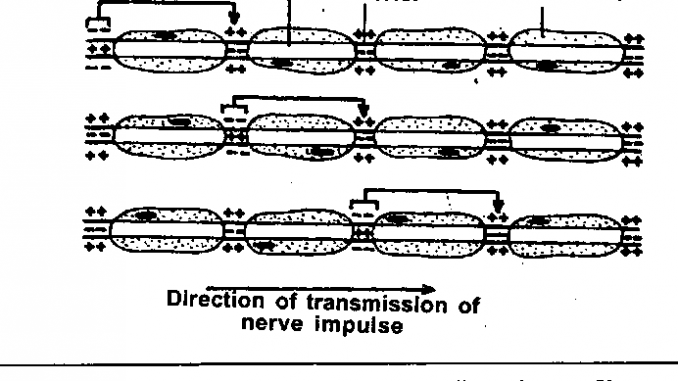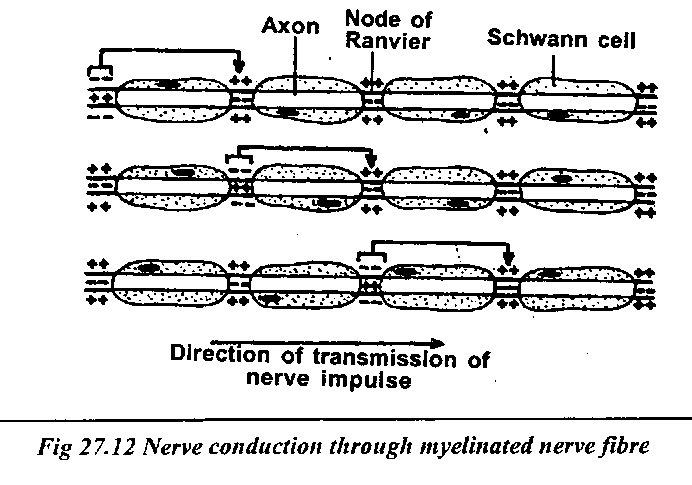
Nerve Impulse Conduction
- Nerve impulse: Nerve impulse is an overall physiological changes that occur in a neuron due mechanical, chemical or electrical disturbance created by a stimulus. It propagation through axon, synapse and neuromuscular junction is called Nerve Impulse conduction.
Nerve Impulse transmission along Neuron
Transmission of nerve impulse along nerve fibre can be summarized in three steps
- Polarization (Resting Potential)
- Depolarization (Action Potential)
- Repolarization
 Figure: nerve impulse transmission along neuron
Figure: nerve impulse transmission along neuron
Polarization (Resting potetential):
- A neuron at resting is electrically charged but not conducting.
- The Axoplasm or plasma membrane of a resting neuron is negatively charged as compared to the interstitial fluid.
- The potential difference measured at this stage is called resting potential which is about -70mV. The interstitial fluid has high concentration of Na+ ion which is about 16 times higher outside the neuron than inside neuron. Similarly, the axoplasm has high concentration of K+ ion which is about 25 times higher inside than in outer interstitial fluids.
- Due to difference in concentration of ions, Na+ ion tends to diffuse into the axoplasm and K+ ion tends to diffuse outside the axoplasm.
- The membrane of neuron at resting is more permeable to K+ ion than Na+ ion. So, K+ leaves the neuron faster than Na+ enter the neuron.
- The difference in permeability results in accumulation of high concentration of cation (+ve charged ion) outside the neuron compared to the concentration of cation inside.
- This state of resting neuron is called Polarized state and it is electro-negatively charged.
Depolarization (Action Potential):
- Any stimulus beyond the threshold can initiate an impulse.
- When such stimulus is applied in the resting neuron, it opens the sodium channel. Now the permeability of Na+ ion suddenly increases at the point of stimulus causing depolarization.
- The diffusion of Na+ ion increases by 10 times from outside to inside. As a result the axoplasm become positively charges, which is exact opposite to polarized state, so called as depolarized state or reverse polarized state.
- The depolarization of the membrane stimulates the adjacent voltage channel, so the action potential passes as a wave along the length of neuron.
Repolarization:
- When the concentration of Na+ ion inside axoplasm increases, the permeability to Na+ decreases and the sodium channel starts to close.
- The Na-K pump activates, so that Na+ are pumped out and K+ inside until the original resting potential is restored. The process is known as repolarization and it starts from the same point from where depolarization starts.
- The entire process of polarization, depolarization and repolarization occur within fraction of seconds. Now, again the neuron is read for another impulse.
Saltatory conduction:
- Transmission of nerve impulses is very rapid. However, nerve impulse conduction along unmyelinated neuron is slow than that of myelinated neuron. It is because, the myelin sheath act as insulator, so that the impulse have to jump from one node of Raniver to another.
- This speed up the conduction process, and this type of conduction is known as Saltatory conduction.

